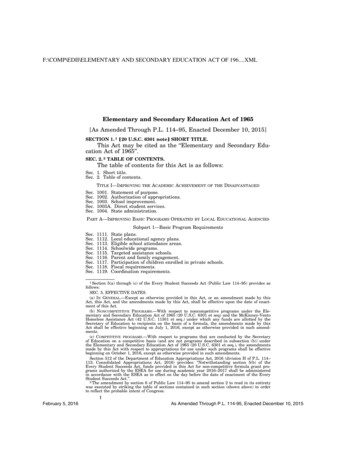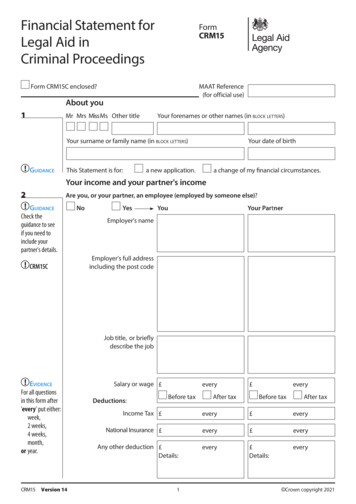
Transcription
The Every Student Succeeds ActEllen Holmes, NBCTDirector of NEA MCEA Center for Organizing’s Montgomery Institute
ESSA Implementation Opportunity After nearly 14 years of asking for less federal intrusion intothe teaching and learning process, it is finally here!– Opportunity for educators to drive teaching and learningdecisions to benefit students– Opportunity to strengthen partnerships with parents,communities, to advocate for what students really need– Must work together to defeat bad ideas and policies at thefederal and state levels that do not benefit students
NEA’s Core Goals for ESEA Reauthorization Promote equity through a newaccountability system with anOpportunity Dashboard as itscenterpiece Decouple high-stakes testingand accountability; promoteless testing to give studentsmore time to learn Ensure qualified educators, andempower them to LEAD!
HUGE OpportunityMembers Said They Want:Opportunities from ESSA: RESOURCES for theirstudents in underservedschools Opportunity Dashboard- toensure their students are gettingwhat they need Pursue social justice for students(equity & opportunity) NETWORK of SUPPORT Build local capacity andassociation-community power Provide value to our affiliates &members Catalyze new forms ofcollaboration at local level VOICE Educator-Driven Policies
Every Student Succeeds ActWhat’s gone?– AYP is gone! No more 100-ways-to-fail!– Federal punitive labels for schools are gone!– Rigid, non-research based interventions aregone!– No more Race to the Top, federally requiredteacher evaluations, based on standardized testscores!– Accountability systems based solely onstandardized tests are gone!
Every Student Succeeds ActWhat concepts remain in new law? High Standards: Every state must have college and careerready standards Statewide Assessments: Maintains testing in grades 3 – 8,once in HS for math and ELA, grade span for science . BUT– Promotes state and local audits to eliminate duplicative orunnecessary tests– New option for HS assessments– New flexibility to create assessment systems that don’t rely onstatewide standardized tests Disaggregation: States still required to look at data fromsubgroups, so groups of students don’t fall through cracks Interventions: Required for low-performing schools, but norigid federally prescribed list; must be evidence-based
What’s different about accountability?Accountability systems at state level cannot be basedsolely on standardized tests!Systems must include:– Math, reading assessments– Graduation rates– Another statewide indicator for middle and elementary schools– English Language Proficiency– At least one indicator of student and school supports (*fromour Opportunity Dashboard!)*95% participation rate*
What about school improvement? States will have to create a system to identify 2 types of schools:– Subgroup schools – identify schools that have consistentlyunderperforming subgroups Differentiation based on all indicators Districts create the school improvement plan – mustmake progress in district-defined # of years– Lowest performing schools – identify bottom 5% of Title Ischools, add high schools with lower than 67% grad rates andlowest subgroup schools Must do a resource equity plan, district developsimprovement plan Improve within 4 years or state needs to do more
What about Educator Voice? Lots of engagement and specificmention of teachers,paraeducators, and specializedinstructional support personnel(SISPs) in decision making Maintained paraprofessionalqualifications from NCLB Committee of Practitioners Huge focus on teachingcontinuum: career ladders,mentoring, professionaldevelopment
Other notable improvements: EXPANDED (yes, expanded)collective bargainingo Now applies to Title II NEW, positive language aboutRestorative Justice; endingthe school-to-prison pipeline Continued, but greater clarityaround Opt Out options forstudents Improvements to charterschool transparency andaccountability
What happens to NCLB Waivers? Built in transition to the new law Identifying subgroup schools begins 2016 – 2017 Full new accountability plans take effect 2017 – 2018 Waivers end in August 2016; USED already releasedguidance on transition
So, everything’s great - right?Not quite.
If changes are not made The new draft regulations don’t remove NCLB’s emphasis ontesting. They state that “robust action” – read: punitiveaction – must be taken against schools that don’t test 95percent of students.
If changes are not made If the proposed regulations are not changed, ESSA’s emphasison closing opportunity gaps would be undermined. DespiteESSA’s statement that the U.S. Department of Educationshould not prescribe the weight of any measure or indicatorused to identify or meaningfully differentiate schools, theproposed regulations would require evidence that stateshave limited the role of the Opportunity Indicators in theaccountability system. As educators, we know thatopportunity and quality indicators are critical to studentsuccess and lead to academic success—things like a menu ofengaging electives, Advanced Placement classes, strongparent and family engagement, full time counselors, nursesand librarians, and early learning program
If changes are not made Despite ESSA’s requirement that states use multiplemeasures for accountability purposes, the proposedregulations also would require that states “assign acomprehensive, summative rating for each school to providea clear picture of its overall standing,” like an A-F grade. Ifchanges aren’t made, the regulations would return to thedamaging NCLB practice of labeling schools and ban the useof dashboards to tell the full story of school progress.
If changes are not made Now is the time to speak up. We have until August 1 to makeour concerns heard on the ESSA regulations and make sure thisnew law becomes the game changer it promised to be.
Make Your Opinions Known NOW GO TO:http://getessaright.org
Let’s take advantage of this opportunity!Let’s join with parents and communities tocreate the schools our students deserve More opportunities for a well-roundededucation More time to learn and less time testing More supports for students and schoolsneeding help Educators and communities drivingdecisions, not politicians
So What’s Next?Hand off coming to states and locals Huge Opportunities to have a seat at the tableand influence multiple decisions, such as: Components of state accountability plans (How much shouldtests count? What school or student supports should beincluded?)Opportunity for local assessment pilotWhat tests should be eliminated?Who will participate on committee of practitioners?How should needs assessments of schools be done?How should interventions be designed and by whom?and the list goes on
Basics of working locally The Who, What,and Outcome Identifying Issues Local Assessment Timeline of Events Detailed Calendar Criteria of our team Who do we need tojoin us? Developing theAskPhase 1:Theory ofChangePhase 2: ESSAOrganizingActionsTeamsPhase 4:Calendar andTimelinePhase 3:CampaignTactics Tactics to win Goals and Metrics
Powerful tactics to consider Local ESSA Implementation Teams Parents as Partners Community Partnerships Community Schools Testing Audits Opportunity Audit using NEA GPS Indicators Professional Development Teams Bargaining strategiesand the list goes on
Great Public SchoolsThe Opportunity Dashboard
ImplementationThe local process Create ESSA Implementation team!Team members should include partners civil rights organizations disability rights organizations Parents (PTA, PTO) community membersSend letter to school board requesting a meeting on ESSADraft a school board resolution requesting ESSA implementation collaborationCollaborate with state ESSA Implementation team, especially on opportunity auditHost local ESSA community briefingConduct local opportunity auditInfluence local planContinue collaboration with state ESSA team and continue to work with the district on adistrict plan
Opportunity AuditWhat is it?nea.org/gpsindicators
Opportunity AuditExample from the guide
Opportunity AuditExample using the DashboardOpportunityDashboardNew JerseyStudent enrollment and successin advanced coursework (AP/IB,honors, dual enrollment, collegegateway math and scienceclasses) Student enrollment in highquality early educationprograms Students’ access to optimalratios of specializedinstructional support personnel(counselors, nurses,psychologists, social workers) 5.8% of African Americanstudents are enrolled incalculus13.1% of African Americanstudents are enrolled inPhysics4.1% of African Americanstudents are enrolled in APForeign Language20.9% of African Americanstudents are enrolled in earlychildhood orprekindergarten programs orservices83.6% of high schools have aschool counselorStudent to counselor ratio359:1 should be (250:1)OpportunityDashboardPaterson, NewJerseyENROLLMENT: 23, 564African American: 28.2%Hispanic: 62%Student enrollment and successin advanced coursework (AP/IB,honors, dual enrollment, collegegateway math and scienceclasses) 0% of the students enrolledin Gifted and Talented areAfrican American students26.7% of the studentsenrolled in calculus areAfrican American23.4% of the studentsenrolled in physics areAfrican AmericanStudent enrollment in highquality early educationprograms 28.2% of the studentsenrolled in early childhoodare African AmericanStudents’ access to optimalratios of specializedinstructional support personnel(counselors, nurses,psychologists, social workers) Total FTE of Counselors :37.9
Resources to consider Alliance to Reclaim Our Schools nter for Popular Democracy Community olsthriving-schoolsParents as essa/
The Every Student Succeeds ActFind out more:Full Draft ESSA a/nprmaccountabilitystateplans52016.pdfNEA’s Front Line Webpage on ESSAwww.nea.org/ESSAbeginsJoin the ESSA Implementation Group on edCommunities:www.mynea360.org/login
What concepts remain in new law? High Standards: Every state must have college and career ready standards Statewide Assessments: Maintains testing in grades 3 - 8, once in HS for math and ELA, grade span for science . BUT -Promotes state and local audits to eliminate duplicative or











